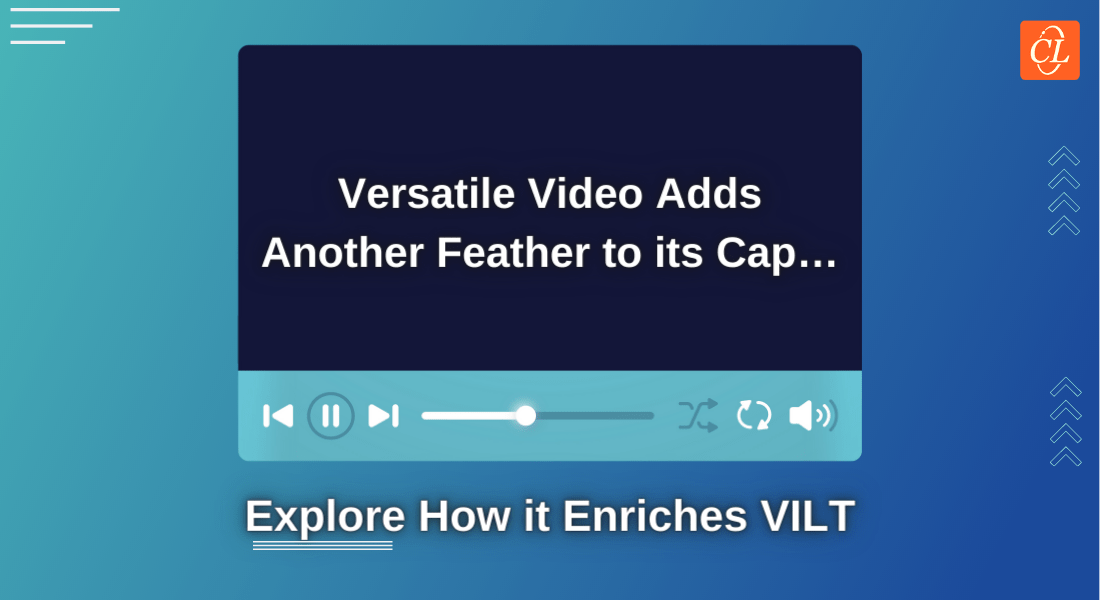How Can Using Videos Supplement Virtual Instructor-led Training?

Virtual Instructor-led Training has proved itself to be a worthy candidate to ensure a seamless learning experience even when other things were at halt. It modified the learning and training approach and adjusted well with the modern-day learning habits. With that said, a major doubt associated with VILT was its effectiveness due to the fact that the interaction happened completely via online channels. Such reasons led to the inclusion of several content formats in the training modules, a video being the most prominent. This blog will briefly explain VILT and why using video is an excellent way to facilitate it.
Benefits of Using Videos in VILT
Listed below are some standout reasons to incorporate videos into your VILT
- Increases retention
- Boosts engagement
- Facilitates the instruction process
- Convenient access
What Is Virtual Instructor-led Training?
Two components define the training style in this term. Firstly, it is virtual, so the instruction takes place digitally, i.e., instructions, lessons, etc., are delivered through video meeting applications designed to facilitate online communication.
Secondly, the training is instructor-led. Instructor-led training is similar to the traditional format only in the aspect that the instructor or an expert is present during the training session. It is a synchronous form of learning that demands the learner and the facilitator to be available at the same time but are not bound to a particular location. Since the learners rely on experts to learn new concepts and acquire knowledge about the topic, VILT is different from self-managed training sessions that deliver the lesson through pre-prepared material. In VILT, learners and the instructor interact, collaborate, and engage in different ways like conducting polls, leveraging breakout rooms, incorporating videos, audios, infographics, storytelling, scenario-based learning, etc.
In nutshell, Virtual Instructor-led Training (VILT) is when an instructor trains the learners virtually via online platforms with the help of slides, videos, lectures, and other material.
Understand VILT in the best way possible with this beginner’s guide. Click now!
How Video Supplements Virtual Instructor-led Training
Videos have become an active mode of interaction among digital natives which has deeply impacted the learning style. Today’s workforce is more inclined toward receiving information visually than simply reading the words. Although the training structure for VILT depends extensively on the learning objectives, availability of training material, and the trainer’s preferences, still there are certain elements that augment the VILT experience for both the facilitator and learners. Videos are one of the most effective and commonly used tools in VILT. If you’re wondering why?
The following are the top benefits of using video-based content for VILT sessions:
Increases Retention
Combining text, verbal, and video formats is an excellent way to increase audience retention. YouTube’s success is a good case study to prove that people pay attention to video content and are more likely to watch it than read several pages of text.
Hence, using videos in the VILT is the right choice as it will help improve knowledge retention among the audience.
Boosts Engagement
Video-based content is beneficial for driving user engagement. Modern technology makes it possible to make simulation videos that require people to engage with the content and make choices along the way, thereby improving the participation rate among the audience. Moreover, videos engage the audio and visual senses of the learner which helps them pay attention.
Additionally, video content is generally successful at getting engagement, prompting the audience to ask questions, comment on aspects, and even interact among themselves. Even better, the facilitator can explain the concept and present a video related to it and ask the learners to teach back. This will keep them attentive and engaged. The higher engagement is a welcome response since it shows people are paying attention to the video content.
Facilitates the Instruction Process
Videos are beneficial for the instruction process and often substitute for physical demonstrations. They are also a good medium to communicate complex ideas that may be difficult to communicate verbally. You can even use videos during the VILT session to explain concepts and processes in a detailed and clear manner.
Additionally, video creators have the freedom to leverage data visualization techniques to ensure optimal information presentation. The better the visualization is, the better people will recall it.
Improves Accessibility
Lastly, videos are conveniently accessible in the virtual training environment. Instructors can show the video through a shared screen or request someone to play a copy on-site. They can also upload it to a public cloud and give the link to all the employees, so they may access the video as per their comfort and requirement.
Although other content formats can also be made available similarly, videos are the most effective, and their convenient accessibility makes them popular.
Types of Videos to Use for Training
The abovementioned benefits prove that videos are helpful for Virtual Instructor-led Training. However, maximizing their benefit requires understanding which video style best suits your training module. Following are the five video types you can choose from:
Context-Setting
Context-setting videos are best when conducting ethics, diversity, or similar kind of training. They help set the context for the content that is to follow to help the audience get accustomed to the topic. They often serve as introductions, especially for people who are less aware of the topic.
Scenario-Based
Scenario-based learning is one of the most used video types for training purposes. Instructors design several relevant training scenarios and present them to the audience to gauge their responses. These responses show the depth of their understanding and allow instructors to redirect explanations when needed.
Story-Based
Story-based videos typically carry important messages, and instructors don’t usually pause them to elaborate on aspects. They know the video’s effectiveness lies in people viewing it without interruptions to get the complete message.
Story-based videos are the least common for technical training and are leveraged more for adding inspiration for the employees.
Explainers
Explainers are similar to instruction videos and support the trainer as they explain the work behind a new software, system, policy, etc. Although these may not seem fun, they can be enjoyable if structured well at the creation time.
There are always ways of presenting explanations excitingly and dynamically to keep people from getting bored and missing any important aspect of the training.
Simulation Videos
Simulation-based training is replicating a real-life scenario in a simulation and acting it out to increase familiarity and understanding. Incorporating such videos is an excellent approach when introducing employees to new machinery or technological tools whose mechanisms they need to understand. The simulation-based video learning will help the learners analyze various aspects of the machinery in detail rather than putting themselves at risk with no prior experience.
Wrapping Up
In short, videos play an instrumental role in Virtual Instructor-led Training programs. They help increase retention, recall, interest, engagement, and participation. Videos try to bridge the physical gap between the learner and facilitator by keeping them both actively involved in the training. Videos in VILTs also help in cost optimization as they eliminate the need for buying training equipment, boost learning, and can be used to customize training modules to suit the employee’s requirements. If you’re looking for more tips, tools, and suggestions to keep your VILT sessions engaging and motivating, check out the eBook link below!





